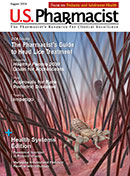In an article published in August 2020 in PLOS Pathogens, researchers from George Washington University examined the potential new role for fingolimod, the FDA-approved drug used to treat exacerbations of multiple sclerosis. This immunosuppressive agent has been proposed as a novel HIV treatment that can block HIV infection and reduce the latent viral pathogen.
Antiretroviral drugs that target various stages of the HIV life cycle have been effective in curbing the AIDS epidemic. However, drug resistance, off-target effects of antiretroviral therapy (ART), and varying efficacy in prevention underscore the need to develop novel and alternative therapeutics. In this study, the authors investigated whether targeting the signaling molecule sphingosine-1-phosphate (S1P), which is known as fingolimod (Gilenya), would inhibit HIV-1 infection and generation of the latent reservoir in primary CD4 T cells.
Senior author, Alberto Bosque, PhD, MBA, assistant professor of microbiology, immunology, and tropical medicine at the George Washington University School of Medicine and Health Sciences and colleagues set out to develop alternative, novel pharmacotherapy to address the ongoing challenges of drug resistance seen with current antiretroviral medications. The researchers explored targeting S1P and considered the signaling molecule and functional antagonist of S1P receptors in combating HIV infection along with what has been termed the “latent reservoir” in primary CD4 T-cells.
The current antiretroviral drugs that target various stages of the HIV lifecycle have been effective; however, the ongoing evolution of drug resistance has limited their future value in the arsenal of a therapeutic toolbox. Dr. Bosque’s team investigated the role of this immunosuppressant in decreasing detectable latent virus by preventing cell-to-cell transmission of the HIV virus. The researchers describe the pharmacotherapeutic action of fingolimod as inhibiting viral fusion and binding, and also decreases the surface density of CD4. Additionally, this agent has been reported to decrease the expression of cyclin D3, along with decreasing the phosphorylation of the HIV restriction factor SAMHD1, which results in decreased “integrated and total” HIV.
According to Dr. Bosque, “While antiretroviral drugs have been effective in treating HIV thus far, drug resistance, negative side effects of antiretroviral therapy, and its varying efficacy underscore the need to develop alternative treatment and prevention options.” He added, “For the first time, our research team found that by targeting the receptors to the signaling molecule Sphingosine-1-phosphate (S1P), we could effectively block HIV infection and cell-to-cell transmission of the virus and consequently reduce the seeding of the latent virus in the test tube.”
The team added that because HIV is a lifelong, chronic disease, the latent reservoir of cells infected with HIV can be reactivated at any time, and current medication does not address exacerbation and reactivation. Therefore, in addition to anti-infective properties, novel treatments should be targeted at reducing this latent viral reservoir. The authors further promote their study impact by reporting that there are nearly 40 million people living with HIV worldwide.
The content contained in this article is for informational purposes only. The content is not intended to be a substitute for professional advice. Reliance on any information provided in this article is solely at your own risk.
« Click here to return to Health Systems Update.






